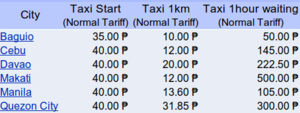

While being a tourist or an expat, you are bound to travel via public transport. Thankfully, the Philippines offer loads of interesting means of transportation!
There are 7,107 islands in the Philippines so island hopping is a popular leisure activity, not to mention a cheap way to travel around the country. However, with a reasonably poor infrastructure and bad safety record expats should be careful when moving around. That said, there is always some sort of cheap transportation available that will take you to your desired location. We are going to discuss some of the transport options available to expats and tourists in the Philippines.
Let us start with travelling on land. Lots of inner-city travel is carried out on “jeepneys”. A jeepney is a combination of a jeep and a bus. An extended jeep, as you may call it. The idea arose because American jeeps were left in the Philippines after the second world war. Jeepneys are pretty confusing and tend to be left to experienced expats or adventurous tourists.
Most rides cost between the 4 and 9 pesos, with an average of 7 pesos, though you will pay a little bit more for the longer journeys. Be sure that you have coins, because paying with a 1,000 peso note will not make you popular. This equals a few days salary to the drivers (it would be like paying your bus driver with a €500 euro).
Be sure that you know where you are going and where to stop because jeepneys drive around everywhere. Be ready to wait for a little while as drivers are allowed to wait until their jeepney is full.
Another option is to take the bus. There is a difference between buses though:
Hints: Prices for a bus with air conditioning can be twice as high as those who do not have it. Be wary as well that bus drivers tend to drive off when the bus is full rather than at set times.
For the shortest trips, you will probably end up in a tricycle. These are motorcycles with a small sidecar attached to it. These can be found everywhere, except on certain city roads, and they will take you anywhere. Costs vary from 2 to 12 pesos, depending on your destination, yet most of the time you will pay around 5 pesos, it’s often best to agree on a price before you get in. This ride can take about 4 people (if you don’t mind squashing in).
Sometimes you need to take a taxi. you can get a taxi easily by just making a sign and empty taxis will use their horn to draw your attention. You may get a taxi more easily at spots such as bus terminals and the airport. http://www.numbeo.com/taxi-fare/country_result.jsp?country=Philippines posted the following data.

The “yellow taxis” from the airports are a lot more expensive.
The most important part is that you make sure that the meter is on! If a driver refuses to do it, get out with your belongings and get another taxi. As a tourist you are bound to pay more.
The train system is somewhat limited in the Philippines, the only track being found on Luzon. Metro Manila has several options for rail travel however.
The Philippine National Railway (PNR) consists of a single line of track. This can be found on the biggest island, Luzon, in the north of the country. It travels from Caloocan to Calamba, with many stops in between.
In Manila expats can make use of the Light Rail Transit (LRT) system as well. There are two lines with a total of 31 stations - the yellow line (LRT1), and the purple line (LRT2). The LRT is a quick and cheap way to travel. For LRT1, passengers are charged up to P20 each for a single journey; for LRT 2, the rate is pegged at P15 each (2013). The train stations are operational from 5:00 am to 10 pm on weekdays and 6:00 am to 8:00 pm weekends.
The third option is the Manila Metro Rail transit system (also known as the MRT3). This system is connected to the Manila light rail transit system. The MRT opens from 5:30 am to 10:30 pm everyday.
With its archipelagic character, you are bound to travel a lot via air or sea within the Philippines.
Ferries are very popular as a cheaper alternative to flying when you need to travel around the country. There is a difference in quality, depending on how much you wish to pay.
Be prepared, ferry trips can take over 24 hours and are often delayed or cancelled. The safety record for sea travel in the Philippines is very poor. Overloading and poor maintenance, coupled with the country’s high typhoon risk means accidents often happen. Make sure that you never board an overloaded boat. Always ask several people whether a boat is full, some may lie to get your spot!
Smaller boats are called fast crafts. Smaller, newer and safer than the ferries, but generally more expensive, fast crafts are becoming a common sight in the Philippines for shorter journeys.
For the smaller distances, locals use “bancas”, which are basically water taxis. A banca is a traditional Filipino canoe, which is also used for fishing and sometimes tourism. Nowadays, most of these are motorised.
For convenience and speed you can opt for a domestic flight, though you should expect to pay more than for a ferry ticket. The five busiest airports in the Philippines are:
The major airlines operating within the Philippines are Cebu Pacific, Philippine Airlines, and PAL Express.